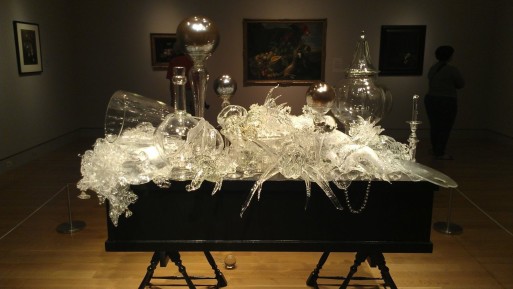Death and mortality have long been a focal point for artists. And it’s no wonder, since life and death are inherent, and an intrinsic part of being human.
Installation artist Beth Lipman works in a medium well-suited for considering mortality: glass.
The light dances off dozens of pieces of clear glass – intricate sculptures of fruit, flowers, candlesticks, wine glasses, bowls and more.
Envision this – you enter an art gallery and wander through the usual exhibits. You then find yourself in the more secluded part of the museum, the part that some people might not even realize exists. You walk into a room, where a dramatically lit still life waits for you. The light dances off dozens of pieces of clear glass – intricate sculptures of fruit, flowers, candlesticks, wine glasses, bowls and more. Everything is set atop a black rectangular box. Upon closer inspection, you might realize that the box is a casket. The wall text accompanying the piece informs you that the casket was custom-made to fit the artist herself.
This is “One and Others” by Beth Lipman.
Lipman actually refers to her glass still life as a funerary piece, and is quoted in the Norton Museum’s magazine as saying, “Glass has a perpetuity, or immortality to it. Even though glass is fragile, it mimics the life cycle. It has a duality to it. It’s fragile and perishable, but also perpetual.”
What a beautiful sentiment. Glass – something so fragile and yet so eternal.
As for the still life itself, not only is the glass itself a representation of the duality of life and death, but the glass sculptures are a more permanent version of the flowers and gifts left at a burial site or atop a coffin.
There are multiple layers to Lipman’s work. It’s evident how much thought went into every part of this still life, from the objects on the table to the fact that, in the Norton Museum, Lipman chose to have her exhibit in a room off the beaten museum path. As for the still life itself, not only is the glass itself a representation of the duality of life and death, but the glass sculptures are a more permanent version of the flowers and gifts left at a burial site or atop a coffin.
Also interesting is that more traditional still lives (those that are painted or drawn) are in essence about mortality. Michael Mills of the New York Times writes that, “still lives are…about the inevitable deterioration, decay, and disintegration of all the abundance that is the ostensible subject of so much still-life painting. It’s a favorite theme of Lipman’s…”
Lipman captures the fleetingness and fragility of life, but also the continuity and resilience of being alive. Her work embodies both the beauty and tragedy inherent in death, and asks viewers to consider their own mortality in a new light.

 Duality: Beth Lipman’s Glass Still Life
Duality: Beth Lipman’s Glass Still Life





 “As Tears Go By” by Marianne Faithfull
“As Tears Go By” by Marianne Faithfull
 “The Sea” by John Banville
“The Sea” by John Banville
 Funeral Favors Offer Visitors a Tangible Memento
Funeral Favors Offer Visitors a Tangible Memento















